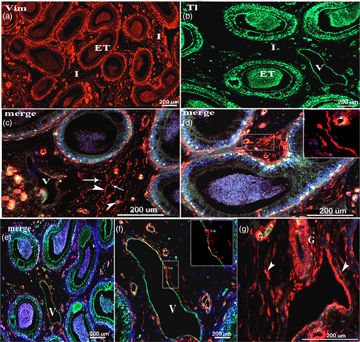Crossref Citations
This article has been cited by the following publications. This list is generated based on data provided by
Crossref.
Sanches, Bruno Domingos Azevedo
Tamarindo, Guilherme Henrique
Maldarine, Juliana Dos Santos
Da Silva, Alana Della Torre
Dos Santos, Vitória Alário
Góes, Rejane Maira
Taboga, Sebastião Roberto
and
Carvalho, Hernandes F.
2021.
Telocytes of the male urogenital system: Interrelationships, possible functions, and pathological implications.
Cell Biology International,
Vol. 45,
Issue. 8,
p.
1613.
Attaai, Abdelraheim H
Hussein, Manal T
Aly, Khaled H
and
Abdel-Maksoud, Fatma M
2022.
Morphological, Immunohistochemical, and Ultrastructural Studies of the Donkey's Eye with Special Reference to the AFGF and ACE Expression.
Microscopy and Microanalysis,
Vol. 28,
Issue. 5,
p.
1780.
Mohamedien, Dalia
and
Awad, Mahmoud
2022.
Pulmonary Guardians and Special Regulatory Devices in the Lung of Nile Monitor Lizard (Varanus niloticus) with Special Attention to the Communication Between Telocyte, Pericyte, and Immune Cells.
Microscopy and Microanalysis,
Vol. 28,
Issue. 1,
p.
281.
Abdellah, Nada
and
Desoky, Sara M. M. El-
2022.
Novel detection of stem cell niche within the stroma of limbus in the rabbit during postnatal development.
Scientific Reports,
Vol. 12,
Issue. 1,
El-Desoky, Sara M. M.
and
Abdellah, Nada
2022.
The morphogenesis of the rabbit meibomian gland in relation to sex hormones: Immunohistochemical and transmission electron microscopy studies.
BMC Zoology,
Vol. 7,
Issue. 1,
Mostafa, Heba
Hussein, Manal T.
and
Abd‐Elnaeim, Mahmoud
2022.
Developmental events in the lung of the Japanese quail (Coturnix coturnix japonica): Morphological, histochemical and electron‐microscopic studies.
Microscopy Research and Technique,
Vol. 85,
Issue. 12,
p.
3761.
Wei, Xiao-jiao
Chen, Tian-quan
and
Yang, Xiao-jun
2022.
Telocytes in Fibrosis Diseases: From Current Findings to Future Clinical Perspectives.
Cell Transplantation,
Vol. 31,
Issue. ,
p.
096368972211052.
Zhu, Xudong
Wang, Qi
Pawlicki, Piotr
Wang, Ziyu
Pawlicka, Bernadetta
Meng, Xiangfei
Feng, Yongchao
and
Yang, Ping
2022.
Telocytes and Their Structural Relationships With the Sperm Storage Tube and Surrounding Cell Types in the Utero-Vaginal Junction of the Chicken.
Frontiers in Veterinary Science,
Vol. 9,
Issue. ,
Yang, Dapeng
Yuan, Ligang
Chen, Shaoyu
Zhang, Yong
Ma, Xiaojie
Xing, Yindi
and
Song, Juanjuan
2023.
Morphological and histochemical identification of telocytes in adult yak epididymis.
Scientific Reports,
Vol. 13,
Issue. 1,
Abdelfattah, Mostafa Galal
Hussein, Manal T.
Ragab, Sohair M. M.
Khalil, Nasser S. Abou
and
Attaai, Abdelraheim H.
2023.
The effects of Ginger (Zingiber officinale) roots on the reproductive aspects in male Japanese Quails (Coturnix coturnix japonica).
BMC Veterinary Research,
Vol. 19,
Issue. 1,
Anwar, Walaa S.
Abdel-maksoud, Fatma M.
Sayed, Ahmed M.
Abdel-Rahman, Iman A. M.
Makboul, Makboul A.
and
Zaher, Ahmed M.
2023.
Potent hepatoprotective activity of common rattan (Calamus rotang L.) leaf extract and its molecular mechanism.
BMC Complementary Medicine and Therapies,
Vol. 23,
Issue. 1,
Abdel‐maksoud, Fatma M.
Zayed, Ahmed E.
Abdelhafez, Enas A.
and
Hussein, Manal T.
2024.
Seasonal variations of the epididymis in donkeys (Equus asinus) with special reference to blood epididymal barrier.
Microscopy Research and Technique,
Vol. 87,
Issue. 2,
p.
326.
Sanches, Bruno D. A.
Teófilo, Francisco B. S.
Brunet, Mathieu Y.
Villapun, Victor M.
Man, Kenny
Rocha, Lara C.
Neto, Jurandyr Pimentel
Matsumoto, Marta R.
Maldarine, Juliana S.
Ciena, Adriano P.
Cox, Sophie C.
and
Carvalho, Hernandes F.
2024.
Telocytes: current methods of research, challenges and future perspectives.
Cell and Tissue Research,
Gan, Quan Fu
Leong, Pooi Pooi
Cheong, Soon Keng
and
Foo, Chai Nien
2024.
Reference Module in Biomedical Sciences.
Zheng, Yonghua
Cai, Songshan
Zhao, Zongfeng
Wang, Xiangdong
Dai, Lihua
and
Song, Dongli
2024.
Roles of telocytes dominated cell–cell communication in fibroproliferative acute respiratory distress syndrome.
Clinical and Translational Discovery,
Vol. 4,
Issue. 2,






